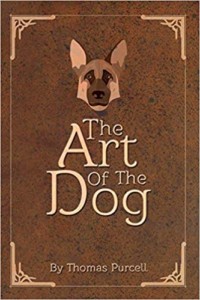Title: The Art of The Dog
Author: Thomas Purcell
Publisher: AuthorHouse
ISBN: 978-1-5462-6637-2
Genre: Non-Fiction
Pages: 117
Reviewed by: Beth Adams
Pacific Book Review
Being a dog lover extraordinaire, I knew from the start that I would enjoy reading Thomas Purcell’s book The Art of the Dog, and I was certainly spot-on. The wisdom of the author’s common sense approach to the interpretation of canine behavior is truly admirable and insightful, and within this book’s covers is a treasure trove of antidotal stories, case studies and his own personal memories of the dogs which he had been once their alpha.
I must admit a tear came to my eye in the first chapter as Thomas Purcell quickly provides his brief history of his past dogs, mentioning the circumstances of how each dog had died. It was like being hit with the ending of Marley and Me a dozen times over at the onset of the book! Purcell’s book proceeded into the body of his messaging which is how to fix dog behavior and make for the synergistically wonderful relationship humans and canines have come to enjoy.
From taking the alpha role in the pack, Purcell devotes an entire chapter on his “Red Leash” approach to maintaining control over one’s dog – that is until the dog begins to respond to voice commands without distraction. From this level of leadership, the author goes on to tell of many instances where he needed to assert his dominance, yet doing so in a kind and persistent manner; not by using forceful or punishing techniques. He is confident in his role of being the alpha, as he says dogs will pick up on any doubt or insecurity you have and challenge you. The animal mainly wants to feel safe with your guidance as the pack leader.
There is a chapter of Qigong (pronounced CHEE-gong) – which is an inwardly meditative approach to using one’s third eye, often said to be one of being able to see colors such as a green glow around a person. This technique was taught to Purcell by Master Robert Peng, world renown for his techniques, and at one point he claims it actually saved his life. The awareness of mentally telepathic communication is also a key point in living with a dog, as the animal’s sensitivity to human emotions cannot be masked or hidden.
The chapters are broken into case studies, in which many of the specific odd behaviors of dogs are discussed along with what actions were taken to remedy the situation. For example, in one case a dog would eat its own poop; whereas the solution of this rather disgusting behavior was the fact the dog was eating his food too fast, leaving undigested dog food in his poop. Another dog would bark at ghosts – or so it seemed. In that instance it was determined the level of carbon monoxide was elevated in the house and the dog was simply warning his human family of the danger. There also was a story about how a dog was overly excited when the family was around, yet calm and relaxed when alone. In this case Purcell noticed the family children were hyper, running and yelling which causes the dog to react; he needed to teach the humans to calm down as it was no fault of the dog’s.
The point of his case studies gets down to the fact that dog owners have to listen to their dogs. There is much to hear from your animal’s behavior. The Art of the Dog is a book which will enhance the enjoyment of living with man’s best friend – and in turn – make for many happy dogs as well. It is a wonderful book to read to learn more about your own dog, or to give out to anyone with a canine member in their family pack.



Follow Us